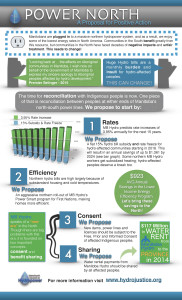 Interchurch Council of Hydropower:
Interchurch Council of Hydropower:
Power North: Positive Action Plan
 More and more non-Indigenous Canadians feel a need for reconciliation with Indigenous people. They believe there is a need to make things right, to live together in a better way. But what exactly might reconciliation look like?
More and more non-Indigenous Canadians feel a need for reconciliation with Indigenous people. They believe there is a need to make things right, to live together in a better way. But what exactly might reconciliation look like?
Hydropower in Manitoba provides a good example. Manitobans are plugged into a massive hydropower system that fundamentally alters the five largest rivers in the province and six of the 12 largest lakes. This has left deep wounds on the landscape and in many people’s hearts. At the same time, this manipulation of waterways provides inexpensive, reliable power for the province.
Premier’s Apology
Last January, Premier Selinger travelled north to publicly apologize to Indigenous people affected by the northern hydropower system. He spoke of the need for reconciliation. As citizens of Manitoba and customers of Manitoba Hydro we, the Interchurch Council on Hydropower, propose four specific steps toward reconciliation.
These suggestions are based in part on what we hear from hydro-affected peoples, what is being done elsewhere in the world, and our own thoughts. Not all hydro-affected peoples will agree with us. Indeed, each person would probably have a somewhat different take on what is needed. And of course there are many other things, many particular to specific communities, that are needed.
Our intent is to open up some space in the public discussion not to get bogged down in particulars, which are clearly up to others to finalize.
From Problems to Solutions
The narrative around northern hydro impacts has too often got stuck on the problems without shifting toward possible solutions. We have been guilty of this as well. Acknowledging the unspeakable, ongoing harm that many places and people experience as a result of dams, now is the time to focus on positive change.
Manitoba Hydro has partnership agreements with five First Nations in the vicinity of new dams. The utility speaks about its new way of doing business in the north. The pros and cons of their “new era” approach are a matter of some debate, but it must be recognized that these partnerships only encompass about one third of hydro-affected peoples in the north. Broader measures are needed.
Bottom Line
Manitoba Hydro has also spent just over $1 billion over its history on compensation and mitigation measures. It has a number of ongoing programs. Still, for us the bottom line is that the northern waterways are a huge mess, many people (not all) feel deep grief over the damage and the ongoing treatment by Hydro, and straightforward steps toward a better future remain unrealized.
We suggest that those steps could include:
1.) Rates
Ironically, people in northern hydro-affected communities pay among the highest hydro bills in the province. While rates per kilowatt hour of electricity are the same throughout the province, heating substandard homes in cold climates is expensive. With high poverty rates in these communities, the weight of these bills is amplified. For many people, their monthly hydro bills arrive as a burden, an insult and a reminder of unfair treatment.
Now Hydro predicts that rates throughout Manitoba will rise by 3.95 percent annually for the next 15 years, in part to pay for the new dams that were supposed to bring prosperity to the north.
We propose that hydro rates for affected communities be reduced by 15 percent immediately and frozen at that rate for 15 years, rather than the planned increases.
In some cases, Hydro employees in Hydro housing up north receive subsidized electricity. Their heating costs are based not on the actual amount of electricity they use, but the cost of heating a home in Winnipeg. For many hydro-affected peoples, the fact that neighbouring Hydro employees receive a break on their bills while hydro-affected people don’t, is salt in the wound.
2.) Efficiency
Another way to reduce hydro bills is to improve the efficiency of homes. Manitoba Hydro’s Power Smart programs are designed to do just that. We propose an aggressive and generous roll-out of Hydro’s “Power Smart and First Nations” program in hydro-affected communities. This would provide training, employment, improved housing stock and lower hydro bills.
3.) Consent
The United Nations Declaration on the Rights of Indigenous Peoples holds up the principle of Free, Prior and Informed Consent. The same concept is included in the World Bank’s draft Environmental and Social Framework.
Industrial activity within territories covered by treaty and considered traditional homelands by Indigenous peoples should be subject to their consent.
Specifically, construction of new dams, construction of new transmission lines and granting of licences for dams—including licence renewals—should be subject to the Free, Prior and Informed Consent of affected Indigenous peoples.
4.) Sharing
We believe the treaties are about living together in a good way and sharing. All of Manitoba Hydro’s operations are on treaty land.
Manitoba Hydro produces about $4.5 million worth of electricity in the north on an average day. The north is a place of wealth and abundance. There is plenty to share. Yet hydro-affected communities remain impoverished. Various factors contribute to this, but local access to local resources would help.
In the last fiscal year, Manitoba Hydro paid $117 million to the provincial government in water rental fees. This is a simple fee based on the amount of electricity produced.
Those annual water rental fee payments money should be shared with affected peoples, and linked to long-term community improvement plans.

